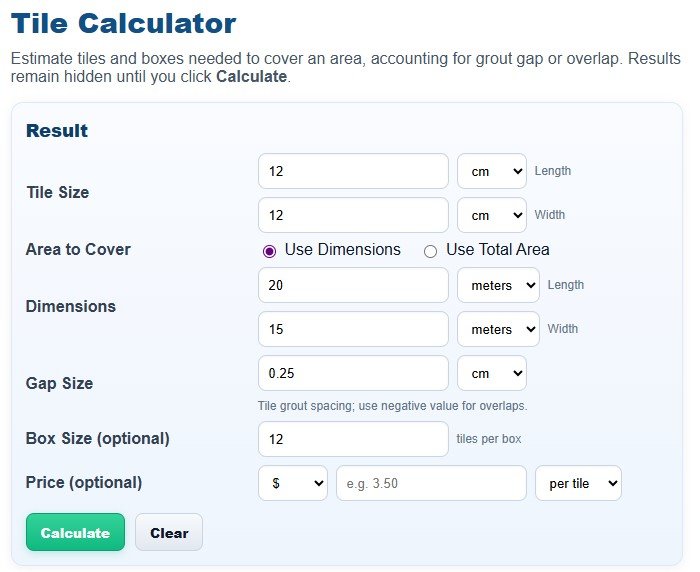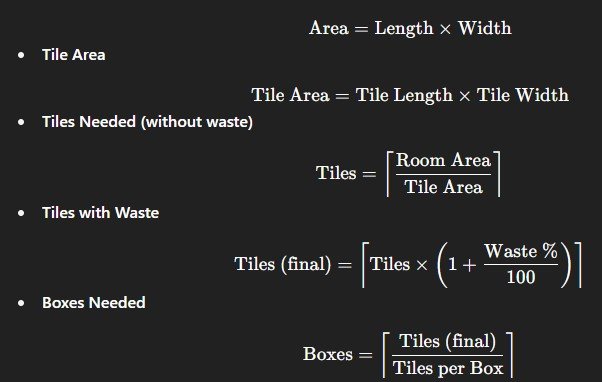[other_tile-calculator_calculator]
Free Tile Calculator – Free Online Tiles Estimator
Planning to tile a room but confused about how many tiles to buy? Don’t worry—I’m here like a friendly teacher to walk you through it. A lot of people either buy too few tiles (and end up rushing back to the store) or buy too many (and waste money). That’s exactly why a Tile Calculator is super helpful. It quickly tells you how many tiles, how many boxes, and even the extra allowance for cuts and breakage you’ll need—without any complicated math.
Whether you’re a student learning practical math, a first-time DIYer, or helping your family plan a small renovation, this free Tile Calculator online makes everything easy. You just enter your room size, tile size, and an optional waste percentage, and it does the rest. In a minute, you’ll learn how to calculate tiles step by step like a pro. Ready? Let’s turn measurements into a clear shopping list—no stress, no guesswork!
What Is This Calculator?
A Tile Calculator helps you estimate the number of tiles and boxes required to cover a floor or wall area. You input:
- Room dimensions (length × width)
- Tile size (length × width)
- Optional waste percentage (for cuts, breakage, patterns)
- Tiles per box (so you know how many boxes to buy)
People use it to avoid underbuying or overspending, plan budgets, and reduce leftover tiles. It solves the common problem of wrong quantity estimates—especially when rooms aren’t perfect rectangles or when you’re using diagonal patterns.
How to Use This Calculator (Step by Step)
- Measure your space
- For rectangular rooms, measure Length and Width (in meters/feet).
- For odd shapes, split the area into smaller rectangles and add them up.
- Enter tile size
- Example: 600 mm × 600 mm (0.6 m × 0.6 m) or 24 in × 24 in.
- Add waste percentage (recommended)
- 5–10% for straight/stack patterns.
- 10–15% for diagonal or complex layouts.
- Enter tiles per box (from tile packaging).
- Optional: Add price per tile/box to estimate total cost.
- Hit Calculate → Get:
- Tiles needed (rounded up)
- Boxes to buy
- Total covered area (and cost, if entered)
Why It Is Useful
- Saves money & time: No more extra store trips or wasted cash on leftover tiles.
- Beginner-friendly: Simple inputs, instant results—perfect for students and first-time renovators.
- Accurate planning: Includes waste factor for cuts and breakage.
- Works for floors & walls: Bedrooms, kitchens, bathrooms, balconies—any space you want to tile.

- Great for budgeting: If you know price per box, you can estimate total cost before buying.
- Contractor-approved: Quick check for procurement and site planning.
Who should use it?
Homeowners, renters, DIY learners, interior design students, and contractors who want fast, reliable tile quantity estimates.
Real-Life Example (Step by Step)
Room: 4.5 m (Length) × 3.2 m (Width)
Tile: 600 mm × 600 mm = 0.6 m × 0.6 m
Waste: 8% (straight pattern)
Tiles per box: 4 tiles/box
1) Room Area = 4.5 × 3.2 = 14.40 m²
2) Tile Area = 0.6 × 0.6 = 0.36 m²
3) Tiles (no waste) = 14.40 ÷ 0.36 = 40 tiles
4) Add Waste (8%) = 40 × 1.08 = 43.2 → 44 tiles (round up)
5) Boxes Needed = 44 ÷ 4 = 11 boxes (round up)
Result Summary:
- Total room area: 14.40 m²
- Tile area: 0.36 m²
- Tiles needed (incl. waste): 44 tiles
- Boxes to buy: 11 boxes
Formula Used Free Online Tiles Estimator
- Room Area (rectangle)

Unit Tips:
- mm to m: divide by 1000 (e.g., 600 mm = 0.6 m)
- in to ft: divide by 12 (e.g., 24 in = 2 ft)
FAQs: Free Online Tiles Estimator
How much extra tile should I buy?
Use 5–10% extra for straight/stack layouts and 10–15% for diagonal or complex patterns. Small rooms with many cuts often need the higher range.
Does grout gap change the calculation?
A small grout gap usually doesn’t change totals much. If your calculator allows, use effective tile size (tile + average grout) for finer accuracy.
Can I use this for wall tiles too?
Yes! The same method works for floors and walls. Just measure the wall area (height × width) and subtract openings (windows/doors) if needed.
What if my room isn’t a perfect rectangle?
Split the space into rectangles/triangles, calculate each area, and add them up. Then follow the same steps.
How do I find tiles per box?
Check the tile box label or product page. Different sizes and brands pack tiles differently.
Should I round up the result?
Always round up tiles and boxes. Tiles can break or need extra cuts—rounding up prevents last-minute shortages.